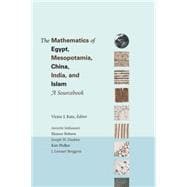
Note: Supplemental materials are not guaranteed with Rental or Used book purchases.
Purchase Benefits
What is included with this book?
| Preface | p. ix |
| Permissions | p. xi |
| Introduction | p. 1 |
| Egyptian Mathematics | |
| Preliminary Remarks | p. 7 |
| Introduction | p. 9 |
| Invention of writing and number systems | p. 13 |
| Arithmetic | p. 14 |
| Metrology | p. 17 |
| Hieratic Mathematical Texts | p. 17 |
| Table texts | p. 18 |
| Problem texts | p. 24 |
| Mathematics in Administrative Texts | p. 40 |
| Middle Kingdom texts: The Reisner papyri | p. 40 |
| New Kingdom texts: Ostraca from Deir el Medina | p. 44 |
| Mathematics in the Graeco-Roman Period | p. 46 |
| Context | p. 46 |
| Table texts | p. 47 |
| Problem texts | p. 48 |
| Appendices | p. 52 |
| Glossary of Egyptian terms | p. 52 |
| Sources | p. 52 |
| References | p. 54 |
| Mesopotamian Mathematics | |
| Introduction | p. 58 |
| Mesopotamian mathematics through Western eyes | p. 58 |
| Mathematics and scribal culture in ancient Iraq | p. 62 |
| From tablet to translation | p. 65 |
| Explananda | p. 68 |
| The Long Third Millennium, c. 3200-2000 BCE | p. 73 |
| Uruk in the late fourth millennium | p. 73 |
| Shuruppag in the mid-third millennium | p. 74 |
| Nippur and Girsu in the twenty-fourth century BCE | p. 76 |
| Umma and Girsu in the twenty-first century BCE | p. 78 |
| The Old Babylonian Period, c. 2000-1600 BCE | p. 82 |
| Arithmetical and metrological tables | p. 82 |
| Mathematical problems | p. 92 |
| Rough work and reference lists | p. 142 |
| Later Mesopotamia, c. 1400-150 BCE | p. 154 |
| Appendices | p. 180 |
| Sources | p. 180 |
| References | p. 181 |
| Chinese Mathematics | |
| Preliminary Remarks | p. 187 |
| China: The Historical and Social Context | p. 187 |
| Methods and Procedures: Counting Rods, The "Out-In" Principle | p. 194 |
| Recent Archaeological Discoveries: The Earliest Yet-Known Bamboo Text | p. 201 |
| Mathematics and Astronomy: The Zhou bi suan jing and Right Triangles (The Gou-gu or "Pythagorean" Theorem) | p. 213 |
| The Chinese "Euclid", Liu Hui | p. 226 |
| The Nine Chapters | p. 227 |
| The Sea Island Mathematical Classic | p. 288 |
| The "Ten Classics" of Ancient Chinese Mathematics | p. 293 |
| Numbers and arithmetic: The Mathematical Classic of Master Sun | p. 295 |
| The Mathematical Classic of Zhang Qiujian | p. 302 |
| Outstanding Achievements of the Song and Yuan Dynasties (960-1368 CE) | p. 308 |
| Qin Jiushao | p. 309 |
| Li Zhi (Li Ye) | p. 323 |
| Yang Hui | p. 329 |
| Zhu Shijie | p. 343 |
| Matteo Ricci and Xu Guangxi, "Prefaces" to the First Chinese Edition of Euclid's Elements (1607) | p. 366 |
| Conclusion | p. 375 |
| Appendices | p. 379 |
| Sources | p. 379 |
| Bibliographic guides | p. 379 |
| References | p. 380 |
| Mathematics in India | |
| Introduction: Origins of Indian Mathematics | p. 385 |
| Mathematical Texts in Ancient India | p. 386 |
| The Vedas | p. 386 |
| The SA'ulbasutras | p. 387 |
| Mathematics in other ancient texts | p. 393 |
| Number systems and numerals | p. 395 |
| Evolution of Mathematics in Medieval India | p. 398 |
| Mathematics chapters in Siddhanta texts | p. 398 |
| Transmission of mathematical ideas to the Islamic world | p. 434 |
| Textbooks on mathematics as a separate subject | p. 435 |
| The audience for mathematics education | p. 477 |
| Specialized mathematics: Astronomical and cosmological problems | p. 478 |
| The Kerala School | p. 480 |
| Madhava, his work, and his school | p. 480 |
| Infinite series and the role of demonstrations | p. 481 |
| Other mathematical interests in the Kerala school | p. 493 |
| Continuity and Transition in the Second Millennium | p. 498 |
| The ongoing development of Sanskrit mathematics | p. 498 |
| Scientific exchanges at the courts of Delhi and Jaipur | p. 504 |
| Assimilation of ideas from Islam; mathematical table texts | p. 506 |
| Encounters with Modern Western Mathematics | p. 507 |
| Early exchanges with European mathematics | p. 507 |
| European versus "native" mathematics education in British India | p. 508 |
| Assimilation into modern global mathematics | p. 510 |
| Appendices | p. 51 |
| Table of Contents provided by Publisher. All Rights Reserved. |
The New copy of this book will include any supplemental materials advertised. Please check the title of the book to determine if it should include any access cards, study guides, lab manuals, CDs, etc.
The Used, Rental and eBook copies of this book are not guaranteed to include any supplemental materials. Typically, only the book itself is included. This is true even if the title states it includes any access cards, study guides, lab manuals, CDs, etc.